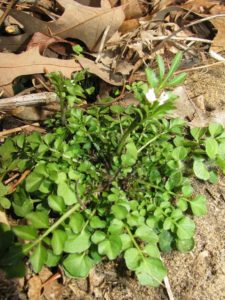Lawns: Winter annual weeds
go.ncsu.edu/readext?645838
en Español / em Português
El inglés es el idioma de control de esta página. En la medida en que haya algún conflicto entre la traducción al inglés y la traducción, el inglés prevalece.
Al hacer clic en el enlace de traducción se activa un servicio de traducción gratuito para convertir la página al español. Al igual que con cualquier traducción por Internet, la conversión no es sensible al contexto y puede que no traduzca el texto en su significado original. NC State Extension no garantiza la exactitud del texto traducido. Por favor, tenga en cuenta que algunas aplicaciones y/o servicios pueden no funcionar como se espera cuando se traducen.
Português
Inglês é o idioma de controle desta página. Na medida que haja algum conflito entre o texto original em Inglês e a tradução, o Inglês prevalece.
Ao clicar no link de tradução, um serviço gratuito de tradução será ativado para converter a página para o Português. Como em qualquer tradução pela internet, a conversão não é sensivel ao contexto e pode não ocorrer a tradução para o significado orginal. O serviço de Extensão da Carolina do Norte (NC State Extension) não garante a exatidão do texto traduzido. Por favor, observe que algumas funções ou serviços podem não funcionar como esperado após a tradução.
English
English is the controlling language of this page. To the extent there is any conflict between the English text and the translation, English controls.
Clicking on the translation link activates a free translation service to convert the page to Spanish. As with any Internet translation, the conversion is not context-sensitive and may not translate the text to its original meaning. NC State Extension does not guarantee the accuracy of the translated text. Please note that some applications and/or services may not function as expected when translated.
Collapse ▲
image by Kerry Wixted ccbync2
Do you remember the weeds that were growing in the lawn last spring? Probably not, but henbit, chickweed, and hairy bittercress are just a few of the unwanted, early spring surprises that are waiting for gardeners. These weeds are called winter annuals, which means they germinate in the fall and grow throughout the winter until they flower and disperse seeds in the spring.
Here in western North Carolina, winter annual weeds are already up and growing. They aren’t noticeable yet, but by March they will be large and unsightly weeds in area lawns. After dispersing seeds, these annual weeds die. But their seeds lie on the ground waiting for the fall, when they germinate and start the cycle all over again.
Breaking this cycle is the key to controlling winter annuals. Weeds must be treated before they start to set seeds in the early spring. As soon as you start seeing annual weeds in late fall, spray the lawn with an herbicide that is listed for them. Then spray again in January and February when the temperature is at least 55°F. Look for herbicides containing dicamba, MCPP, and 2,4-D, but check the label for proper application method, timing, and target weed and lawn species.
Timing is critical in lawn weed control. Applying pesticides at the right time can take care of pesky weed problems and leave the lawn weed-free. If you aren’t sure of what kind of weed you have, check the NC Extension Gardener Plant Toolbox, or your local Extension agent can help you with identification if you get samples to an agent while the weeds are still alive. Driving weeds samples around in the car for several days makes identification difficult! For more information on managing weeds in lawns, see the “Lawns” chapter of the NC Extension Gardener Handbook.
— Donna Teasley
Additional interesting articles are linked from the index
Extension Gardener Newsletter


